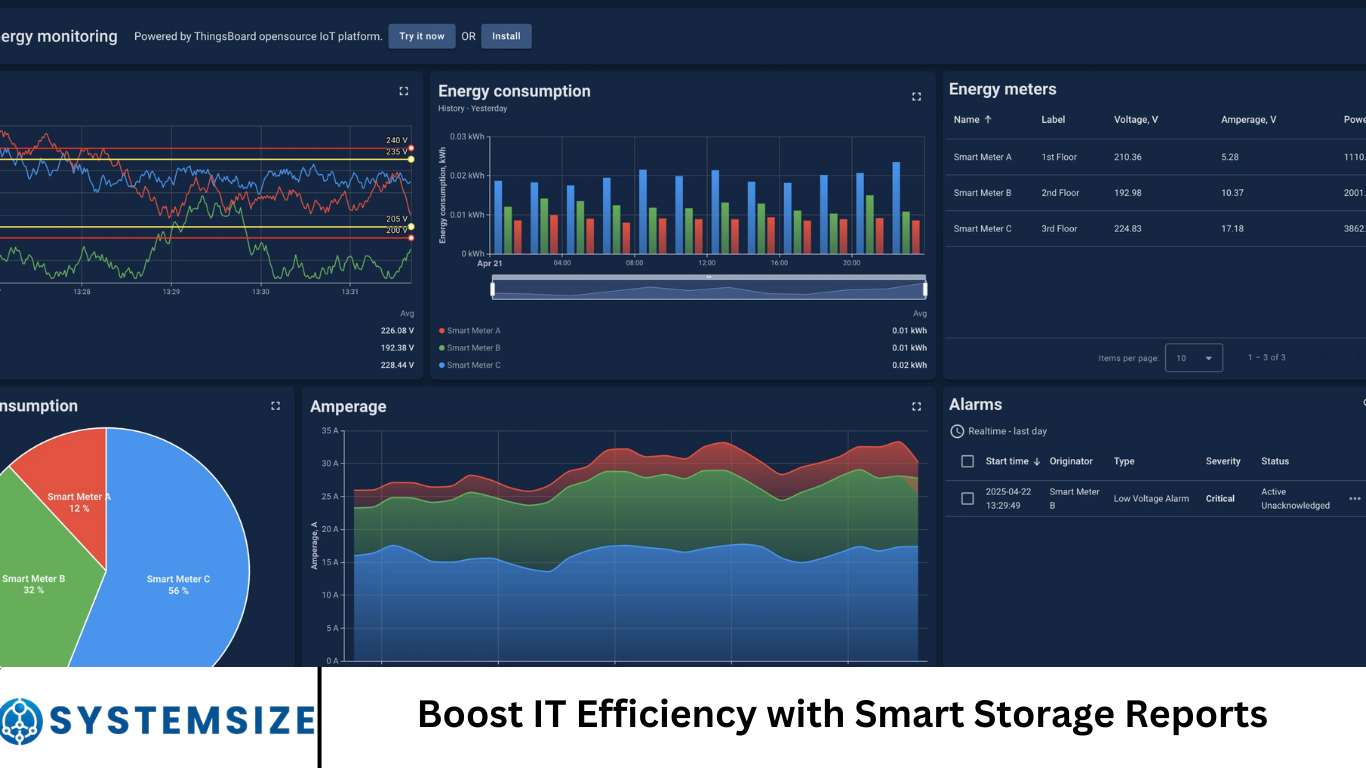Data-driven world, effective IT management means staying ahead of storage demands. As organizations generate massive volumes of data—user files, databases, backups, logs, virtual machines—it’s easy for storage to become chaotic.
One day you’re fine, the next you’re scrambling to carve out more capacity or dealing with performance bottlenecks. That’s where Smart Storage Reports come into play: they turn raw metrics into clear insights, empowering sysadmins to optimize performance, reduce costs, and maintain compliance—all with minimal fuss.
This guide explains how storage reports help, why many organizations still struggle, and best practices for generating insightful analytics that transform your IT operations.
More Read: Distributed File Systems Explained: The Complete Guide
1. Why Smart Storage Reports Matter
Visibility = Proactive Decisions
Without proper visibility, you’re essentially flying blind. Smart storage reports give you:
- Real‑time metrics: utilization, IOPS, latency, snapshot and clone stats.
- Trending and forecasting: so you know when capacity will hit thresholds.
- Heatmaps and tier usage: see which volumes are hot, which are cold, and whether tiering is effective.
- Compliance snapshots: track data retention, duplication, and archival state.
Collectively, these insights help make proactive decisions—avoiding outages, scrub issues before they escalate, streamline growth planning, and ensure regulatory alignment.
Reduce Costs Without Sacrificing Performance
Storage is often one of the largest line items on any IT budget. Without smart reporting:
- You may overbuy hardware to avoid pain.
- You may undersize and suffer frequent disruptions.
- You miss optimization opportunities like reclaiming unused blocks.
Smart storage reporting identifies unused snapshots, orphaned volumes, and underutilized tiers—immediately turning potential savings into real ones.
Boost SLA Adherence and Customer Satisfaction
Service Level Agreements (SLAs) often hinge on:
- Guaranteed uptime
- Minimum latency
- Data availability and backing
By monitoring degraded volumes or capacity spikes early, you ensure SLAs are met and stakeholders remain happy.
2. The Anatomy of Smart Storage Reports
Smart storage reports are more than just a CSV dump. They’re a blend of data, clarity, and actionability.
Key Metrics to Include
To maximize insight, focus on metrics such as:
- Total vs. used vs. free capacity, across each storage pool/array.
- IOPS, throughput (MB/s), and latency, per workload or application.
- Snapshot usage and retention, including frequency, size, and age.
- Tier utilization, distinguishing between hot, warm, and cold data.
- Orphaned resources: snapshots no longer tied to a VM or database.
- Growth trends, showing month‑over‑month and year‑over‑year curves.
Heatmaps and Visualization
Seeing is understanding:
- Heatmaps: visualize IOPS and latency—quickly spot hot-spots.
- Trendlines: capacity usage and performance over time.
- Pie/bar charts: distribution across tiers or departments.
- Alert overlays: highlight when thresholds were crossed.
Forecasting and Predictive Analytics
Smart reports take you beyond current state:
- Forecast consumption with linear or seasonally adjusted trends.
- Identify volume-level growth, flagging those that could breach thresholds.
- Recommend next best steps—allocate capacity, shift tiers, archive data.
Policy and Compliance Dashboards
Regulatory and governance needs are critical. Reports should:
- List volumes past data-retention policies.
- Flag snapshots exceeding retention windows.
- Highlight encryption or access misconfiguration.
- Document any capacity threshold that might break SLA.
3. Common Pitfalls in Storage Reporting
Relying on Manual Snapshots
Manual processes that use spreadsheets or ad-hoc exports can:
- Miss real-time spikes.
- Contain inconsistencies between snapshots.
- Require combing through silent failures or stale data.
Ignoring Context
Without linking to applications or users, you won’t know:
- Why certain volumes show heavy I/O.
- If rapid file growth is normal (e.g., annual backups) or abnormal.
Contextual metadata helps focus reports on business impact—not just numbers.
Undervaluing Automation
Regular reporting must be scheduled:
- Daily or weekly storage summaries.
- Automatic alerting for capacity thresholds.
- Integrate with ticketing systems via API.
Manual refreshes won’t cut it at scale.
4. Tools and Technologies You Can Use
Storage-Provided Reporting Features
Many arrays (e.g., NetApp, EMC, Pure Storage) include reporting dashboards:
Pros:
- Native integration, accurate metrics.
- Heatmaps/fresh data with minimal setup.
Cons:
- Often siloed to their own ecosystem.
- May lack forecasting, cross-array analytics.
These are best for small environments or simple needs.
Unified Monitoring Platforms
Platforms like SolarWinds Storage Manager, Nagios XI, Zabbix, or PRTG centralize metrics across vendors.
Advantages:
- Centralized heatmaps, cross-array trending.
- Alerting, predictive tools built-in.
Analytics and BI Tools
When you need advanced reporting:
- Export metrics to Power BI, Tableau, or log analytics platforms.
- Build customized dashboards with SQL, Python, or R integrations.
- Predictive forecasting with machine learning models.
Custom Scripting + APIs
For tech-savvy teams:
- Use vendor APIs (REST, PowerShell) to pull daily snapshots.
- Store data in a central time-series DB (InfluxDB, Prometheus).
- Dashboard via Grafana or Kibana—customizable and powerful.
5. Step-by-Step Guide: Building a Smart Storage Report
Define Objectives and Audience
- Is this for IT ops, compliance, finance, or executives?
- Decide on level of detail (overall capacity vs. volume-level IOPS).
- Determine frequency and distribution (daily email, weekly PDF dashboard, monthly exec summary).
Identify Data Sources
List all your storage systems:
| Vendor/Platform | Type | Access Method |
|---|---|---|
| Pure Storage | All-flash array | REST API/SNMP |
| NetApp ONTAP | Hybrid SSD/HDD | ONTAP API |
| AWS EBS/EFS | Cloud volumes | AWS SDK/API |
| vSphere Datastores | VMFS/NFS | vCenter API |
Pull Baseline Data
Gather:
- Total, used, free for each pool/volume/day.
- IOPS, latency, throughput.
- Snapshot counts and sizes.
- Tier usage and dedupe stats.
- Metadata tags (owner, application, retention rules).
Build Reporting Logic
Create your dashboard logic:
- Calculate dashboard KPIs: % utilization, IOPS per GB, data growth %.
- Set thresholds: e.g., 85% used → alert; 5% weekly growth → investigate.
- Forecast: using linear regression for future capacity consumption.
- Include actionable recommendations (e.g., “Expand pool by 2TB,” “Delete 5 stale snapshots,” “Move VMFS1 to tier‑2”).
Create Visualizations
Use:
- Heatmaps: IOPS/latency per array.
- Line/area charts: capacity trends.
- Bar graphs: tier-level heat or departmental breakdown.
- Pie charts: snapshot vs. live data storage.
- Alerts & callouts: highlight issues in red.
Automate Collection and Delivery
- Schedule data collection via cron, platform tasks, or scripts.
- Send compiled reports via email, Teams channel, or BI portal.
Review and Iterate
- Gather team feedback.
- Adjust thresholds.
- Add context (e.g., tag by project or app owner).
- Start cross-correlating with tickets and performance issues.
6. Sample Scenario: Real-World Use Case
Company X, a mid-sized SaaS provider, faced surprise outages due to sudden I/O bottlenecks on their NetApp SAN. They introduced a Smart Storage Reporting pipeline with:
- Daily metrics via ONTAP API (capacity, IOPS).
- Grafana dashboards for team-wide visibility.
- Alerts at 90% capacity and 10ms latency.
- Weekly forecast emails highlighting volumes trending above thresholds.
Outcomes:
- Outages dropped by 75%.
- Storage procurement decreased by 20% via tiering and reclaim.
- SLA violations diminished due to proactive handling.
7. Advanced Tips & Best Practices
Tag Everything Semantically
Ensure volumes/snapshots have tags like app=CRM, owner=finance, retention=30d. Filtering and reporting becomes much easier.
Include Storage Cost Metrics
When possible, include $ per GB cost in dashboards. Charge-backs or show-backs enhance accountability.
Correlate with VM and App Monitoring
Tie storage issues to affected VMs or services. For example: “Latency spike on volume V1 correlates with high CPU on VM2.”
Regular Report Audits
Periodically:
- Clean up stale volumes.
- Adjust retention.
- Confirm tags and ownership are up-to-date.
- Archive cold data or migrate to cheaper tiers/cloud.
Embrace Forecasting
Forecast beyond linear—use seasonal modeling, ARIMA, ML methods for predictable workloads.
Maintain Clean Archive and Tiering Policies
Smart reporting helps ensure you’re seeing the right data at the right time—not everything forever.
Frequently Asked Question
What are Smart Storage Reports?
Smart storage reports are detailed, automated summaries of your IT storage systems, highlighting metrics like capacity usage, performance (IOPS, latency), snapshot data, and growth trends. They help IT teams monitor, forecast, and optimize storage infrastructure efficiently.
How do Smart Storage Reports improve IT efficiency?
Smart storage reports improve IT efficiency by providing real-time visibility into storage performance and capacity. They help detect bottlenecks, reclaim unused space, avoid over-provisioning, and ensure compliance—all of which reduce manual effort, costs, and downtime.
What should be included in a Smart Storage Report?
A comprehensive smart storage report should include:
- Total and used capacity
- IOPS and latency trends
- Tier usage (hot, warm, cold data)
- Snapshot and backup statistics
- Growth forecasts
- Policy and compliance flags
- Visual dashboards (heatmaps, graphs)
Which tools can generate Smart Storage Reports?
Popular tools that generate smart storage reports include:
- SolarWinds Storage Resource Monitor
- NetApp OnCommand Insight
- PRTG Network Monitor
- Zabbix
- Grafana (with InfluxDB or Prometheus)
- Cloud-native tools like AWS CloudWatch, Azure Monitor
Can storage reports help reduce IT costs?
Yes, smart storage reports can reveal inefficiencies like underutilized volumes, stale snapshots, and opportunities for tiering or archiving. By acting on these insights, businesses can significantly reduce hardware spend and cloud storage bills.
Are Smart Storage Reports useful for compliance and audits?
Absolutely. Storage reports help track data retention policies, encryption status, access permissions, and backup integrity. This is essential for meeting compliance standards like GDPR, HIPAA, or ISO 27001.
How often should Smart Storage Reports be generated?
The frequency depends on your IT environment. For most organizations:
- Daily reports monitor critical performance and capacity changes.
- Weekly reports focus on growth trends and proactive planning.
- Monthly executive summaries highlight cost, risks, and ROI for stakeholders.
Conclusion
Smart Storage Reports are your compass in the data wilderness—guiding you to optimal performance, cost control, and compliance. By combining real-time metrics, trend forecasting, and automated delivery, you turn storage from a reactive pain point into a strategic asset. Aligning technical measures with business goals—from SLAs and charge-backs to cost awareness—elevates your role from system caretaker to operations strategist. Start small: pick a key metric (like daily capacity trends), build a weekly email, add a heatmap, then scale. With each iteration, you’ll sharpen insight, improve your bottom line, and sleep better knowing nothing is slipping through the cracks.


